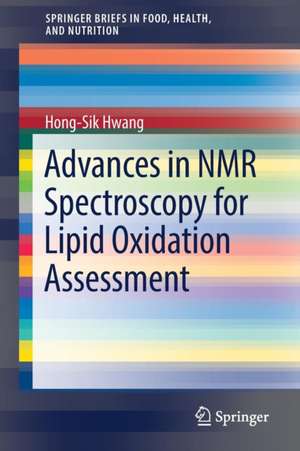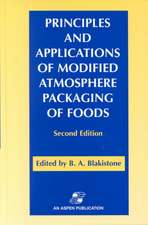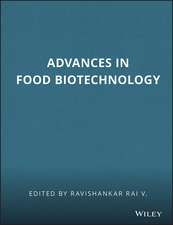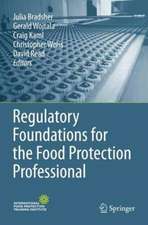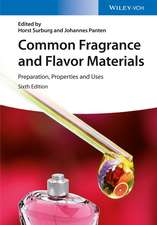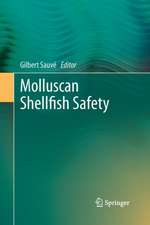Advances in NMR Spectroscopy for Lipid Oxidation Assessment: SpringerBriefs in Food, Health, and Nutrition
Autor Hong-Sik Hwangen Limba Engleză Paperback – 22 feb 2017
Advances in NMR Spectroscopy for Lipid Oxidation Assessment begins by covering the various mechanisms of lipid oxidation, including various methods to determine oxidation products. NMR spectroscopy is then covered, including its applications in foods. The next section focuses on 1H NMR Spectroscopy, including its use for assessment of lipid oxidation during oil storage and frying. The following section focuses on 13C NMR spectroscopy, including its use in determining and identifying oxidation products and mechanisms. A final section focuses on 31<
Din seria SpringerBriefs in Food, Health, and Nutrition
-
 Preț: 378.12 lei
Preț: 378.12 lei -
 Preț: 381.00 lei
Preț: 381.00 lei -
 Preț: 408.82 lei
Preț: 408.82 lei -
 Preț: 380.07 lei
Preț: 380.07 lei -
 Preț: 381.00 lei
Preț: 381.00 lei -
 Preț: 471.95 lei
Preț: 471.95 lei -
 Preț: 377.18 lei
Preț: 377.18 lei -
 Preț: 379.09 lei
Preț: 379.09 lei -
 Preț: 379.09 lei
Preț: 379.09 lei -
 Preț: 374.46 lei
Preț: 374.46 lei -
 Preț: 374.46 lei
Preț: 374.46 lei -
 Preț: 377.18 lei
Preț: 377.18 lei -
 Preț: 375.45 lei
Preț: 375.45 lei -
 Preț: 374.85 lei
Preț: 374.85 lei -
 Preț: 377.18 lei
Preț: 377.18 lei - 20%
 Preț: 322.50 lei
Preț: 322.50 lei -
 Preț: 374.08 lei
Preț: 374.08 lei -
 Preț: 376.80 lei
Preț: 376.80 lei -
 Preț: 348.40 lei
Preț: 348.40 lei -
 Preț: 380.84 lei
Preț: 380.84 lei -
 Preț: 376.80 lei
Preț: 376.80 lei -
 Preț: 378.34 lei
Preț: 378.34 lei -
 Preț: 382.95 lei
Preț: 382.95 lei -
 Preț: 374.08 lei
Preț: 374.08 lei -
 Preț: 377.95 lei
Preț: 377.95 lei -
 Preț: 377.35 lei
Preț: 377.35 lei -
 Preț: 374.85 lei
Preț: 374.85 lei -
 Preț: 375.84 lei
Preț: 375.84 lei -
 Preț: 376.04 lei
Preț: 376.04 lei -
 Preț: 377.18 lei
Preț: 377.18 lei -
 Preț: 375.62 lei
Preț: 375.62 lei -
 Preț: 411.32 lei
Preț: 411.32 lei -
 Preț: 379.86 lei
Preț: 379.86 lei -
 Preț: 379.30 lei
Preț: 379.30 lei -
 Preț: 376.96 lei
Preț: 376.96 lei -
 Preț: 352.58 lei
Preț: 352.58 lei -
 Preț: 352.97 lei
Preț: 352.97 lei -
 Preț: 380.25 lei
Preț: 380.25 lei -
 Preț: 373.54 lei
Preț: 373.54 lei -
 Preț: 343.00 lei
Preț: 343.00 lei -
 Preț: 375.45 lei
Preț: 375.45 lei -
 Preț: 412.30 lei
Preț: 412.30 lei
Preț: 375.23 lei
Nou
Puncte Express: 563
Preț estimativ în valută:
71.81€ • 74.69$ • 59.28£
71.81€ • 74.69$ • 59.28£
Carte tipărită la comandă
Livrare economică 14-28 aprilie
Preluare comenzi: 021 569.72.76
Specificații
ISBN-13: 9783319541952
ISBN-10: 3319541951
Pagini: 82
Ilustrații: IX, 59 p. 15 illus.
Dimensiuni: 155 x 235 x 4 mm
Greutate: 0.11 kg
Ediția:1st ed. 2017
Editura: Springer International Publishing
Colecția Springer
Seria SpringerBriefs in Food, Health, and Nutrition
Locul publicării:Cham, Switzerland
ISBN-10: 3319541951
Pagini: 82
Ilustrații: IX, 59 p. 15 illus.
Dimensiuni: 155 x 235 x 4 mm
Greutate: 0.11 kg
Ediția:1st ed. 2017
Editura: Springer International Publishing
Colecția Springer
Seria SpringerBriefs in Food, Health, and Nutrition
Locul publicării:Cham, Switzerland
Cuprins
Conventional Analytical Methods to Assess Lipid Oxidation and Their Problem.- Mechanisms of Lipid Oxidation.- Methods to Determine Primary Oxidation Products.- Methods to.- Determine Oxidation Products.- Application of NMR Spectroscopy in Foods and Its Advantages.- 1H NMR Spectroscopy for Assessment of Lipid Oxidation.- Assessment of Oxidation during Oil Storage.- Assessment of Oxidation during Frying.- Comparison between 1H NMR Spectroscopy and Conventional Analytical Methods.- 1H NMR Spectroscopy for Identification of Oxidation Products and for Elucidation of Reaction Mechanisms.- 13C NMR spectroscopy for Assessment of Lipid Oxidation.- Use of 13C NMR spectroscopy for Determination of Oxidation.- Use of 13C NMR spectroscopy for Identification of Oxidation Products and Mechanisms.- 31P NMR spectroscopy for Assessment of Lipid Oxidation.- Conclusions and Future Prospects.
Notă biografică
Dr. Hong-Sik Hwang is a Research Chemist at the National Center for Agricultural Research at the US Department of Agriculture in Peoria, IL, USA.
Textul de pe ultima copertă
This Brief provides a comprehensive overview of NMR spectroscopy, covering techniques such as 1H, 13C, and 31P NMR, which are reliable tools to determine lipid oxidation level, to identify oxidation products, and to elucidate oxidation mechanism. The Brief shows that 1H NMR spectroscopy continually demonstrates reliability, accuracy, convenience, and advantages over conventional analytical methods in determination of the level of oxidation of edible oil during frying and storage through monitoring changes in several proton signals of oil, including olefinic, bisallylic and allylic protons. This modern analytical method is shown within this text to be used to identify oxidation products, including primary oxidation products such as hydroperoxides and conjugated dienes and secondary products such as aldehydes, ketones, epoxides and their derivatives. By identifying intermediates and final oxidation products, many oxidation mechanisms could be elucidated. A relatively newer method, the text demonstrates that 13C NMR and 31P NMR spectroscopy can also provide additional information on the molecular structure of an oxidation product. Backgrounds, principles, and advantages over conventional methods, most recent advances, and future prospects of these methods are discussed.
Advances in NMR Spectroscopy for Lipid Oxidation Assessment begins by covering the various mechanisms of lipid oxidation, including various methods to determine oxidation products. NMR spectroscopy is then covered, including its applications in foods. The next section focuses on 1H NMR Spectroscopy, including its use for assessment of lipid oxidation during oil storage and frying. The following section focuses on 13C NMR spectroscopy, including its use in determining and identifying oxidation products and mechanisms. A final section focuses on 31P NMR spectroscopy for assessment of lipid oxidation.
Advances in NMR Spectroscopy for Lipid Oxidation Assessment begins by covering the various mechanisms of lipid oxidation, including various methods to determine oxidation products. NMR spectroscopy is then covered, including its applications in foods. The next section focuses on 1H NMR Spectroscopy, including its use for assessment of lipid oxidation during oil storage and frying. The following section focuses on 13C NMR spectroscopy, including its use in determining and identifying oxidation products and mechanisms. A final section focuses on 31P NMR spectroscopy for assessment of lipid oxidation.
Caracteristici
Provides a comprehensive overview of NMR spectroscopy for lipid oxidation assessment in foods Details NMR Spectroscopy in foods and its advantages for assessment of oxidation during both oil storage and frying Covers both 13C NMR and 31P NMR spectroscopy and their uses in determining and identifying oxidation products and mechanisms Includes supplementary material: sn.pub/extras
